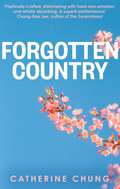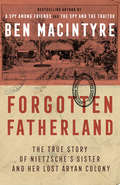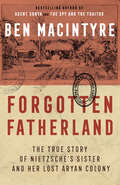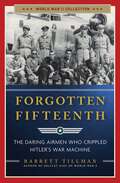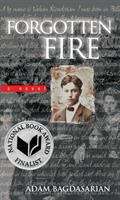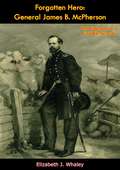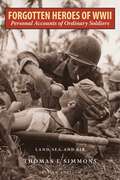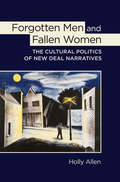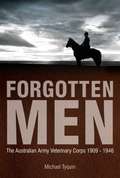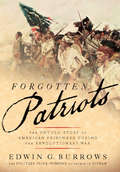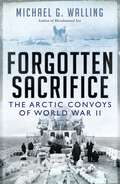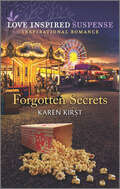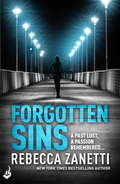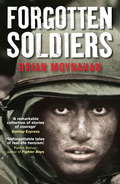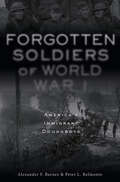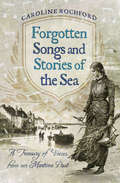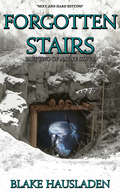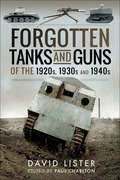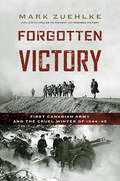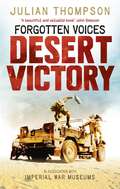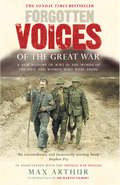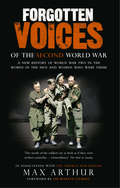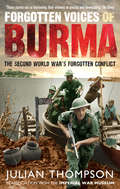- Table View
- List View
Forgotten Child: The brand new heartwarming historical romance novel from the Sunday Times bestselling author
by Katie FlynnFrom Sunday Times bestselling author Katie Flynn, Forgotten Child is a heartbreaking, uplifting and totally transporting novel to curl up with by the fire.Scotland, 1940: Isla Donaghue is just sixteen when her mother dies, and her idyllic life comes to an abrupt end. Unable to cope, Isla’s father sends her to the poorhouse when he joins the merchant navy.Horrified at the harsh conditions of the poorhouse, Isla is determined to escape. Enlisting the help of her newfound friends Meg and Sophie, she devises a plan to flee to Liverpool.Despite the difficulties of her new life and the dangers of the Luftwaffe, Isla falls in love for the first time. But her beau is not all that he seems… Will true love prevail or will secrets from the past put an end to their happiness?Why readers love Katie Flynn... 'Takes you on a journey of heartbreak and joy''Hard to put down''Her characters are like old friends''Heartwarming romance'
Forgotten Country
by Catherine Chung'A richly emotional portrait of a family that had me spellbound from page one' Cheryl Strayed, bestselling author of WildThe night before Janie's sister, Hannah, is born, her grandmother tells her a story: Since the Japanese occupation of Korea, their family has lost a daughter in every generation, and Janie is told to keep Hannah safe. Years later, when Hannah cuts all ties and disappears, Janie goes to find her. It is the start of a journey that will force her to confront her family's painful silence, the truth behind her parents' sudden move to America twenty years earlier, and her own conflicted feelings toward Hannah.Weaving Korean folklore with a modern narrative of immigration and identity, Forgotten Country is a gripping story of a family struggling to find its way out of silence and back to one another.
Forgotten Fatherland: The True Story of Neitzche's Sister and Her Lost Aryan Colony
by Ben MacintyreFrom the bestselling, acclaimed author of A Spy Among Friends, The Spy and the Traitor, and Rogue Heroes, the fascinating story of Elisabeth Nietzsche's maniacal attempt to found a utopian colony in the jungles of Paraguay in the late nineteenth century.In 1886 Elisabeth Nietzsche, the bigoted, imperious sister of the famous philosopher, founded a "racially pure" colony in Paraguay together with her husband, anti-Semitic agitator Bernhard Förster, and a band of fair-skinned fellow Germans. In 1991 Ben Macintyre tracked down the survivors of Nueva Germania, as the colony was called, and found a strange, tight-lipped people, still interbreeding to the point of genetic deterioration. Digging into recently opened German archives, Macintyre tells how Elisabeth, who returned to Germany in 1893, grafted her anti-Semitic, nationalist ideas onto her brother's philosophy, building a mythic cult around him. Elisabeth later became a mentor to Hitler; her stately funeral in 1935 was attended by a tearful Führer. Laced with mordant irony, Macintyre's brilliant piece of investigative journalism adds weight to the view, shared by many scholars, that the Nazis' use of Friedrich Nietzsche's ideas to justify their evil deeds and doctrines was a perversion of his thought.
Forgotten Fatherland: The True Story of Nietzsche's Sister and Her Lost Aryan Colony
by Ben Macintyre&“A fascinating, provocative, and highly eccentric volume&” (The New York Times) exploring the true story of Elisabeth Nietzsche&’s maniacal attempt to found a utopian colony in the jungles of Paraguay in the late nineteenth century—from the bestselling author of Prisoners of the Castle.In 1886, Elisabeth Nietzsche, the bigoted, imperious sister of the famous philosopher, founded a &“racially pure&” colony in Paraguay with her husband, anti-Semitic agitator Bernhard Förster, and a band of fair-skinned fellow Germans. More than a century later, Ben Macintyre tracked down the survivors of Nueva Germania to discover the remains of this bizarre colony, and found a strange, tight-lipped people, still interbreeding to the point of genetic deterioration. Digging into recently opened German archives, Macintyre unfolds how Elisabeth, who returned to Germany in 1893, grafted her anti-Semitic, nationalist ideas onto her brother&’s philosophy, building a mythic cult around him, and how she later became a mentor to Hitler—her stately funeral in 1935 attended by a tearful Führer. Laced with mordant irony, Macintyre&’s brilliant piece of investigative journalism explores how the Nazis perverted Friedrich Nietzsche&’s ideas to justify their evil deeds, and unearths a rich and disturbing vein of the twentieth century&’s dark history.
Forgotten Fifteenth: The Daring Airmen Who Crippled Hitler's War Machine (World War II Collection)
by Barrett TillmanNovember 1943-May 1945-The U.S. Army Air Forces waged an unprecedentedly dogged and violent campaign against Hitler's vital oil production and industrial plants on the Third Reich's southern flank. Flying from southern Italy, far from the limelight enjoyed by the Eighth Air Force in England, the Fifteenth Air Force engaged in high-risk missions spanning most of the European continent. The story of the Fifteenth Air Force deserves a prideful place in the annals of American gallantry. <P><P>In his new book, Forgotten Fifteenth: The Daring Airmen Who Crippled Hitler's War Machine, Tillman brings into focus a seldom-seen multinational cast of characters, including pilots from Axis nations Romania, Hungary, and Bulgaria and many more remarkable individuals. They were the first generation of fliers-few of them professionals-to conduct a strategic bombing campaign against a major industrial nation. They suffered steady attrition and occasionally spectacular losses. In so doing, they contributed to the end of the most destructive war in history. <P><P>Forgotten Fifteenth is the first-ever detailed account of the Fifteenth Air Force in World War II and the brave men that the history books have abandoned until now. Tillman proves this book is a must-read for military history enthusiasts, veterans, and current servicemen.
Forgotten Fire
by Adam BagdasarianIn 1915 Vahan Kenderian is living a life of privilege as the youngest son of a wealthy Armenian family in Turkey. This world of comfort and security is shattered when some family members are whisked away and others are murdered before his eyes. In too short a time, Vahan loses his home and family and, to survive, is forced to live a life he could never have dreamed of. Somehow Vahan’s incredible strength and spirit help him endure even when he knows that each day could be his last.
Forgotten Hero: The Biography of a Civil War General
by Elizabeth J. WhaleyFirst published in 1955, this is a fascinating biography of General James Birdseye McPherson (1828-1864), a career United States Army officer who served as a general in the Union Army during the American Civil War.The story carries McPherson from his birth near Clyde, Ohio in 1828 to his sudden death during the Battle for Atlanta in 1864. Son of pioneer parents who migrated to northern Ohio from upstate New York in the 1820’s, McPherson, showing promise in school and at his store job, won an appointment to West Point, where he graduated top of the class of 1853. There followed a year of teaching mathematics at the military academy and then assignments with the corps of engineers, first at New York, where he served with William T. Sherman, then at San Francisco, where his task was strengthening the Alcatraz Island fortifications.Shortly after the onset of the Civil War, McPherson requested a transfer to the Corps of Engineers to further his career and, departing California in August 1861, he requested a position on the staff of Maj.-Gen. Halleck. McPherson’s career began to flourish after this assignment, rising through the ranks and battles to become Major-General and given command of Grant’s Army of Tennessee in March 1864. Sherman began his Atlanta Campaign in May 1864, with McPherson and his army constituting the right flank, and it was during the Battle of Atlanta in July 1864 that McPherson left his permanent mark on the history of his country when he lost his life as the second highest-ranking Union officer killed during the war.“In presenting this story of his life, I have tried to bring out an officer whose dynamic personality was reflected in the results of many engagements on the battlefield; a gentleman whose talent for friendship and love for people endeared him to thousands; a leader whose quick decisions and wise, cool judgments were needed after the noise of battle had subsided.”—Elizabeth J. Whaley
Forgotten Heroes of World War II: Personal Accounts of Ordinary Soldiers—Land, Sea, and Air
by Thomas E. SimmonsWorld War II was the defining event of the twentieth century. For everyone it was a time of confusion, fear, destruction, and death on a scale never before seen. Much has been written of the generals, campaigns, and battles of the war, but it was young, ordinary American kids who held our freedom in their hands as they fought for liberty across the globe. Forgotten Heroes of World War II offers a personal understanding of what was demanded of these young heroes through the stories of rank-and-file individuals who served in the navy, marines, army, air corps, and merchant marine in all theaters of the war. Their tales are told without pretense or apology. At the time, each thought himself no different from those around him, for they were all young, scared, and miserable. They were the ordinary, the extraordinary—the forgotten.
Forgotten Men and Fallen Women: The Cultural Politics of New Deal Narratives
by Holly AllenDuring the Great Depression and into the war years, the Roosevelt administration sought to transform the political, institutional, and social contours of the United States. One result of the New Deal was the emergence and deployment of a novel set of narratives—reflected in social scientific case studies, government documents, and popular media—meant to reorient relationships among gender, race, sexuality, and national political power. In Forgotten Men and Fallen Women, Holly Allen focuses on the interplay of popular and official narratives of forgotten manhood, fallen womanhood, and other social and moral archetypes. In doing so, she explores how federal officials used stories of collective civic identity to enlist popular support for the expansive New Deal state and, later, for the war effort.These stories, she argues, had practical consequences for federal relief politics. The “forgotten man,” identified by Roosevelt in a fireside chat in 1932, for instance, was a compelling figure of collective civic identity and the counterpart to the white, male breadwinner who was the prime beneficiary of New Deal relief programs. He was also associated with women who were blamed either for not supporting their husbands and family at all (owing to laziness, shrewishness, or infidelity) or for supporting them too well by taking their husbands’ jobs, rather than staying at home and allowing the men to work.During World War II, Allen finds, federal policies and programs continued to be shaped by specific gendered stories—most centrally, the story of the heroic white civilian defender, which animated the Office of Civilian Defense, and the story of the sacrificial Nisei (Japanese-American) soldier, which was used by the War Relocation Authority. The Roosevelt administration’s engagement with such widely circulating narratives, Allen concludes, highlights the affective dimensions of U.S. citizenship and state formation.
Forgotten Men: The Australian Army Veterinary Corps 1909-1946 (Big Sky Publishing Ser.)
by Michael TyquinForgotten Men is the long overdue account of the significant contribution to the Australian Army of the Australian Army Veterinary Corps in two world wars. One of the army's smallest and least recognised corps, its humble beginnings and quiet work in the background belie the crucial role of the Corps in supporting wartime operations and dealing with logistical issues never envisaged before 1915. While their place in military history is often overlooked, the men of the Australian Veterinary Corps deserve recognition. Stoic and hardworking, they unselfishly worked among the horrors of war, to provide the support needed for army units and their animals. While the Veterinary Corps reached its peak during the Great War, its role did not end when the guns fell silent in 1918. Instead, the Corps continued to support military activities across Australia until horsepower finally gave way to mechanisation in World War II. The Corps' success in enabling the 1st Australian Imperial Force to fight in two theatres, each with its own peculiar veterinary problems, is an achievement worth recording. Doctor Michael Tyquin is a consulting historian based in Canberra. He has published extensively in the areas of Australian social, medical and military history. He is a serving member of the Australian Army Reserve which he joined as a medical assistant with the 4/19th Prince of Wales Light Horse. He is the official historian of the Royal Australian Army Medical Corps and is an Adjunct Professor at the University of Queensland's Centre for Military and Veterans' Health.
Forgotten Patriots: The Untold Story of American Prisoners During the Revolutionary War
by Edwin G. BurrowsBetween 1775 and 1783, some 200,000 Americans took up arms against the British Crown. Just over 6,800 of those men died in battle. About 25,000 became prisoners of war, most of them confined in New York City under conditions so atrocious that they perished by the thousands. Evidence suggests that at least 17,500 Americans may have died in these prisons--more than twice the number to die on the battlefield. It was in New York, not Boston or Philadelphia, where most Americans gave their lives for the cause of independence. New York City became the jailhouse of the American Revolution because it was the principal base of the Crown’s military operations. Beginning with the bumper crop of American captives taken during the 1776 invasion of New York, captured Americans were stuffed into a hastily assembled collection of public buildings, sugar houses, and prison ships. The prisoners were shockingly overcrowded and chronically underfed--those who escaped alive told of comrades so hungry they ate their own clothes and shoes. Despite the extraordinary number of lives lost, Forgotten Patriots is the first-ever account of what took place in these hell-holes. The result is a unique perspective on the Revolutionary War as well as a sobering commentary on how Americans have remembered our struggle for independence--and how much we have forgotten.
Forgotten Sacrifice: The Arctic Convoys of World War II
by Michael WallingHitler called Norway the "Zone of Destiny" for Nazi Germany because convoys from Churchill's Britain and Roosevelt's United States supplied Stalin's Soviet Russia with critical equipment and foodstuffs during the darkest days of the German invasion.The words "Murmansk Run" conjure visions of ice-laden ships and thoughts of freezing to death in seconds. For five long years, thousands of men and women fought ferociously in the coldest corner of hell on earth. Some fought for survival, some struggled to help others survive, and some sought to crush their enemies. If man-made death didn't get you, the Arctic's weapons of ice and cold would. These natural weapons killed regardless of whose side you were on or how just was your cause. No one escaped unscathed. Author Mike Walling captures the Arctic convoys' bitter essence in Forgotten Sacrifice. The story launches in October 1939, when Germany and the Soviet Union began diplomatic maneuvering. The action accelerates with Winston Churchill's decision in 1941 to provide supplies to Soviet forces battling the German invasion. From this point until the closing days of WWII in spring 1945, an unremitting sea battle raged within the confines of the always-lethal, ever-shifting Arctic ice pack and the savage Scandinavian coastline. Nearly 4.5 million tons of supplies were moved in 77 convoys over the course of 5 years in order to help the Soviet war effort. The Allies fought to keep the sea lanes open to Murmansk while the Germans were determined to slaughter every ship which dared to make the attempt. By the end of the convoys, 98 ships had been lost. Forgotten Sacrifice reveals a timeless tale of determination, heroism, sacrifice, and the strength of the human spirit.From the Hardcover edition.
Forgotten Secrets
by Karen KirstThey attacked him and abducted the woman he was with. But he can’t remember why—and has to trust a beautiful Marine sergeant to help him find out . . . Left with amnesia after he was attacked and the heiress with him was kidnapped, Gray Michaelson has no clue why he’s in North Carolina. As the only witness, Sergeant Catriona Baker could be the answer to everything—if they can put the pieces together in time.But one thing is clear: the abductors will kill whomever stands in their way. And Cat is their next target . . .
Forgotten Sins: Sin Brothers Book 1 (Sin Brothers #1)
by Rebecca ZanettiForgotten Sins is the first book in New York Times bestselling author Rebecca Zanetti's thrilling romantic suspense series, Sin Brothers, that will be loved by fans of Karen Rose, Kylie Brant, Elaine Levine, Maya Banks's KGI series and Lisa Jackson.His secrets can destroy her... But her love can save him... From the moment Josie laid eyes on sexy, mysterious Shane Dean, she was in love. Their desire ignited a passionate affair, and within weeks, Shane had slipped a ring on her finger. It seemed her every fantasy was coming true...until her new husband disappeared without a trace. Now, two years and one broken heart later, Josie is shocked when the hospital calls: Shane has been found...at a crime scene with no memory of how he got there.Shane can't remember the blue-eyed angel at his bedside - or who he even is - but he knows something isn't right. His hearing is razor sharp, his physical strength incredible, and the urge to protect Josie overwhelming. For powerful enemies are hunting him, and Josie is the key to discovering why. As Shane struggles to unravel his past, dangerous new truths come to light. Can he protect the only woman he's ever loved? And can Josie trust a man she thought she knew - one who carries such a deadly secret?For more addictive romantic suspense look out for the rest of the titles in the Sin Brothers series and the spin-off series, Blood Brothers: Deadly Silence, Lethal Lies and Twisted Truths. And for breathtaking passion played out against a dangerous race for survival, look for the titles in The Scorpius Syndrome series: Mercury Striking, Shadow Falling and Justice Ascending.
Forgotten Soldiers
by Brian MoynahanForgotten Soldiers is an enthralling work of military history that shows how the courage, intelligence or simple good fortune of the individual can exert a decisive influence on the outcome of a battle or campaign. It tells the stories of fifteen unsung heroes, none of a rank higher than major, whose deeds changed the course of important battles and - arguably - the course of history. These vivid and gripping accounts - largely drawn from the Second World War, but with tales too from other conflicts - have each been selected to illustrate one of the dictums of the great Prussian theorist of war, Carl von Clausewitz, about the importance of having the right man in the right place at the right time. From the Roman standard bearer who plunged into the waves off Deal in 55 BC, saving Julius Caesar's military honour and political career, to the young Israeli tank lieutenant who almost single-handedly stalled the advancing Syrian armour in 1973, these are above all tales of courage. But it is not just courage that wins wars, as these stories demonstrate: such elements as surprise, determination, good intelligence, chance, insight, inventiveness and clear thinking all play their parts in eventual victory. And it may only take one man, often of lowly rank, his name largely forgotten, to embody such qualities for the effect to be felt around the world.
Forgotten Soldiers of WWI: America's Immigrant Doughboys
by Alexander F. Barnes Peter L. BelmonteDuring World War I, hundreds of thousands of foreign-born soldiers served in the US military
Forgotten Songs and Stories of the Sea: A Treasury of Voices from our Maritime Past
by Caroline RochfordA collection of fascinating folklore and maritime trivia about pirates, explorers, naval battles, shipwrecks, sea monsters, and more. Stirring tales of heroism at sea have been ingrained in the annals of maritime history from time immemorial. Christopher Columbus&’s discovery of the New World, Queen Elizabeth I&’s defeat of the Spanish Armada, and Horatio Nelson&’s victory at Trafalgar are just some of Britain&’s most memorable naval triumphs. But what about the lesser-known tales from its seafaring past? The Victorian who invented a swimming machine in order to cross the English Channel; the capture of a real-life mermaid; the lost pirate treasure of Alborn; the ghost of a murdered sailor who still haunts the streets of Portsmouth; and the daring explorers who vanished into the blue yonder, leaving behind nothing but a cryptic message in a champagne bottle—these are just some of the quirky naval stories that have been chronicled in verse and archived in newspaper clippings, and forgotten with the passage of time. Historian and genealogist Caroline Rochford has compiled 200 traditional songs and stories into this book, which offers an exciting, entertaining and eye-opening glimpse into a long-lost maritime past.
Forgotten Stairs (Native Silver #2)
by Blake Hausladen“It has been weeks since I finished it and I still catch myself drifting off into daydreams about it as I walk to or from work.” – Shane, GoodreadsThis novella is also available in the omnibus collection, Native Silver.Dia, Matron of Urnedi, is attacked as Enhedu grows. Sikhek, a powerful Hessier, transforms his ideals.And a forgotten stairway might be the key to saving Enhedu. “Murder is no tool of Hers. It is a tool of men. And it will not be a thuggish band of backwoods savages that retakes this cold earth. It will be a kingdom of learned men and professional soldiers that sees Her restored.” – Selt (Chapter 17, Native Silver)The Vestal SeriesA tale of violent magic, intrigue, and statecraft, the Vesteal Series is the story of four souls that are banished beyond the edge of the map to a land of gnarled forests, ancient magic, and the site of a terrible murder. Their struggles to survive will put them at odds with their families, their nation, and the very powers that shaped the world.1. Ghosts in the Yew Novella 1 - Beyond the Edge Novella 2 - Opposing Oaths Novella 3 - Reckless Borders Novella 4 - Bayen's Women Novella 5 - Falling Tides2. Native Silver Novella 1 - Sutler's Road Novella 2 - Forgotten Stairs Novella 3 - Thrall's Wine Novella 4 - Corsair Princess Novella 5 - Tanayon Born 3. The Vastness Novella 1 - Silent Rebellion Novella 2 - The River War Novella 3 - The Blinded Novella 4 - Crimson Valley Novella 5 - Singer's Reward“I was impressed with the attention to detail and the thought the author put into creating the religions, traditions and history of the place.” – Heather, Goodreads
Forgotten Tanks and Guns of the 1920s, 1930s and 1940s
by David ListerHistory forgets. Files are lost and mislaid. But this book seeks to shine a light, offering a collection of cutting edge pieces of historical research detailing some of the most fascinating arms and armament projects from the 1920s to the end of the 1940s, nearly all of which had previously been lost to history.Included here are records from the UKs MI10 (the forerunner of GCHQ) which tell the story of the mighty Japanese heavy tanks and their service during the Second World War. Other chapters expand on the development of British armour, including the story of infantry tanks from the 1920s right through to the end of the Second World War and beyond.Other items placed beneath the microscope in this fascinating history include a wide variety of guns, rocket launchers, super heavy tanks and countless pieces of specialised armour. Previously overlooked, hidden under layers of dust in archives up and down the country, the histories of these objects has finally been uncovered.
Forgotten Victory
by Mark ZuehlkeDuring the winter of 1944-45, the western Allies desperately sought a strategy that would lead to Germany's quick defeat. After much rancorous debate, the Allied high command decided that First Canadian Army would launch the pivotal offensive to win the war-an attack against the Rhineland, an area of Germany on the west bank of the Rhine. Winning this land would give them a launching point for crossing the river and driving into Germany's heartland. This was considered the road to victory. For those who fought, the names of battlegrounds such as Moyland Wood and the Hochwald Gap would forever call up memories of uncommon heroism, endurance and tragic sacrifice. Their story is one largely lost to the common national history of World War II. Forgotten Victory gives this important legacy back to Canadians.
Forgotten Voices Desert Victory
by Julian Thompson Imperial War Museum‘Between Friday and Monday we never slept at all. Everyone’s face was one mass of sand … The guns were so hot, all the paint had gone’ Bombardier Ray EllisHad the Allies lost in North Africa, Rommel’s Afrika Korps would have swept through the Middle East, cutting the vital supply line through the Suez Canal to Australia and India, and taking the oilfields of the Persian Gulf. Britain would have been isolated, without oil, and unable to fight.These historic battles of 1940–1943 were fought over vast distances on rugged terrain, with supply lines often stretched to breaking point. It was here that David Stirling formed the SAS to perform audacious sabotage missions, and the Long Range Desert Group collected intelligence from behind enemy lines.This is the story of the Allies’ first victory against Hitler’s army, told in the voices of the men who were there, which proved that the seemingly unstoppable Germans could be beaten.
Forgotten Voices Of The Great War
by Max ArthurIn 1960, the Imperial War Museum began a momentous and important task. A team of academics, archivists and volunteers set about tracing WWI veterans and interviewing them at length in order to record the experiences of ordinary individuals in war. The IWM aural archive has become the most important archive of its kind in the world. Authors have occasionally been granted access to the vaults, but digesting the thousands of hours of footage is a monumental task. Now, forty years on, the Imperial War Museum has at last given author Max Arthur and his team of researchers unlimited access to the complete WWI tapes. These are the forgotten voices of an entire generation of survivors of the Great War. The resulting book is an important and compelling history of WWI in the words of those who experienced it.
Forgotten Voices Of The Second World War: A New History of the Second World War in the Words of the Men and Women Who Were There
by Max ArthurThe Imperial War Museum holds a vast archive of interviews with soldiers, sailors, airmen and civilians of most nationalities who saw action during WW2. As in the highly-acclaimed Forgotten Voices of the Great War, Max Arthur and his team of researchers spent hundreds of hours digging deep into this unique archive, uncovering tapes, many of which have not been listened to since they were created in the early 1970s. The result will be the first complete oral history of World War 2. We hear at first from British, German and Commonwealth soldiers and civilians. Accounts of the impact of U.S. involvement after Pearl Harbour and the major effects it had on the war in Europe and the Far East is chronicled in startling detail, including compelling interviews from U.S. and British troops who fought against the Japanese. Continuing through from D-Day, to the Rhine Crossing and the dropping of the Atom Bomb in August 1945, this book is a unique testimony to one of the world's most dreadful conflicts. One of the hallmarks of Max Arthur's work is the way he involves those left behind on the home front as well as those working in factories or essential services. Their voices will not be neglected.
Forgotten Voices of Burma: The Second World War's Forgotten Conflict
by Julian ThompsonFrom the end of 1941 to 1945 a pivotal but often overlooked conflict was being fought in the South-East Asian Theatre of World War 2 - the Burma Campaign.In 1941 the Allies fought in a disastrous retreat across Burma against the Japanese - an enemy more prepared, better organised and more powerful than anyone had imagined. Yet in 1944, following key battles at Kohima and Imphal, and daring operations behind enemy lines by the Chindits, the Commonwealth army were back, retaking lost ground one bloody battle at a time.Fighting in dense jungle and open paddy field, this brutal campaign was the longest fought by the British Commonwealth in the Second World War. But the troops taking part were a forgotten army, and the story of their remarkable feats and their courage remains largely untold to this day.The Fourteenth Army in Burma became one of the largest and most diverse armies of the Second World War. British, West African, Ghurkha and Indian regiments fought alongside one another and became comrades. In Forgotten Voices of Burma - a remarkable new oral history taken from Imperial War Museum's Sound Archive - soldiers from both sides tell their stories of this epic conflict.
Forgotten Voices of D-Day: A Powerful New History of the Normandy Landings in the Words of Those Who Were There
by Roderick Bailey6 June 1944: the day Allied forces crossed the Channel and began fighting their way into Nazi-occupied Northwest Europe. Initiated by airborne units and covered by air and naval bombardment, the Normandy landings were the most ambitious combined airborne and amphibious assault ever attempted. Their success marked the beginning of the end for Nazi Germany.Drawing on thousands of hours of eyewitness testimony recorded by the Imperial War Museum, Forgotten Voices of D-Day tells the compelling story of this turning point in World War 2. Hearing from paratroopers and commandos, glider pilots and landing craft crewmen, airmen and naval personnel, we learn first-hand what it was like as men waited to go in, as they neared the beaches and drop zones, and as they landed and met the enemy. Accounts range from memories of the daring capture of 'Pegasus' bridge by British glider-bourn troops to recollections of brutal fighting as the assault forces stormed the beaches. Featuring a mass of previously unpublished material, Forgotten Voices of D-Day is a powerful and important new record of a defining moment in modern history.

